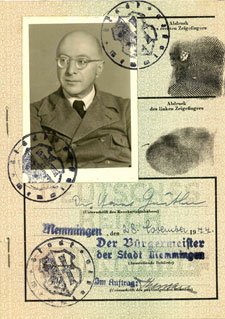Testimonies of Courage among Civilians: Solidarity
A forged identity card bearing the name of Dr. Hans Günther enabled Dr. Hermann Pineas, a physician originally from Berlin, to survive in the underground. Pineas, head of the Jewish Hospital’s neurology department as of 1939, and his wife Herta went underground on March 6, 1943. Mr. Pineas fled to Vienna. His wife found shelter in Berlin in changing quarters.
Both eventually went to Württemberg where, cared for by members of the “parsonage chain” also called the Circle of Brethren, they were put up by various families. In particular, Margarete Hoffer, a vicar in Schwenning, took care of Pineas and his wife.
Married pastors and their wives, Theodor and Hildegard Dipper, Richard and Hilde Gölz, Otto and Gertrud Mörike, Kurt and Elisabeth Müller and Eugen and Johanna Stöffler, and individual pastors’ wives, Elisabeth Goes, Maria Kleinknecht and Hildegard Spieth, also did what they could to save at least seventeen people; they provided shelter and organized other hiding places.
Comparable networks also provided emergency assistance to Jews in hiding in Pomerania, where Pastor Karl-Heinrich Reimer managed to locate new hiding places and prospective lodgings.
In Berlin, a circle of helpers for individuals in hiding arose in the parish in Dahlem, affiliated with the Confessing Church. These helpers were often “persons of mixed blood” or “privileged Jews” personally affected by persecution. Members of the circle were Dr. Franz Kaufmann, Helene Jacobs, Edith Wolff and Ernst Hallermann.
The circle was exposed in August of 1943. Kaufmann was executed by firing squad in Sachsenhausen concentration camp in February of 1944; other members were given prison sentences, sometimes of several years.
In Berlin, the pastors Wilhelm Jannasch and Harald Poelchau, both members of the Confessing Church, also offered refuge to people in hiding. Jannasch helped the Krakauers, a Jewish married couple, and the Jewess Beate Steckhan go into hiding. Poelchau was a chaplain at Tegel Prison and found the Jewess Annemarie Hirsch her first place to live after she went underground. Hirsch commuted to Berlin, Niedersachsen and Hessen where she found shelter in parsonages and other quarters. In Dahlem, she lived to see Soviet troops liberate the city.
Poelchau also helped Erika Charlotte Paech, who belonged to a resistance group of Jewish Communists in Berlin. He found her lodgings with Dorothea Schneider. Dorothea and her daughter Christa Maria Schneider, members of the Confessing Church in Potsdam, saved the lives of several victims of persecution. Poelchau was recognized in Israel as “Righteous among the Nations” in 1972 and awarded the Yad Vashem Medal.
Heinrich Held and Johannes Böttcher, pastors in Essen, also demonstrated solidarity with the victims of persecution. Held and his wife Hildegard first hid former district court judge Hans Werner Perls, who had gone into hiding from imminent deportation, in the cellar of the parsonage and later provided shelter to city planner Dr. Philipp Rappaport, who had escaped a labor camp.
Böttcher hid a group of Jews under the ruins of the bombed out Church of the Reformation in Rüttenscheid. Discrete helpers from the congregation helped him care for them and procure the necessary food. Held and Mr. and Mrs. Böttcher were recognized with the honorific “Righteous among the Nations” posthumously on September 16, 2003.
A diaconial facility provided safety for some twelve Jewish and “half-Jewish” children. Ernst Horn, director of Godesheim, an Inner Mission home founded in 1888, managed to hide these children, often unaware of their own ancestry, in the home’s school classes, even in its own Hitler Youth groups. The children went undiscovered and survived.
Source / title
- © Leo Baeck Institute, ME 502

